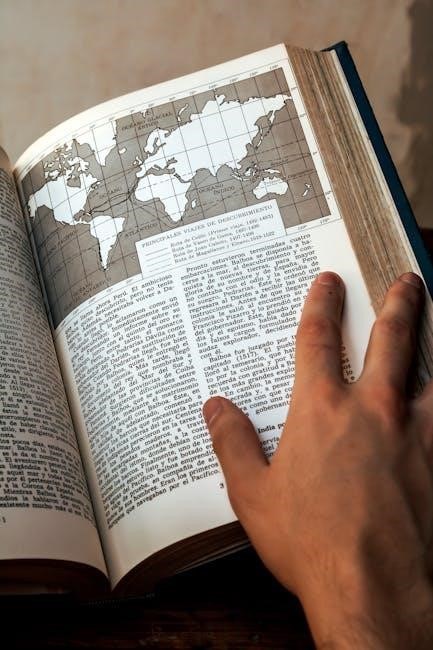World War I, often called the Great War, was a global conflict from 1914 to 1918, involving major powers and causing widespread destruction and societal change․
1․1 Overview of World War I
World War I (1914–1918) was a global conflict involving major powers divided into the Allied and Central Powers․ It started in Europe but spread to colonies and the U․S․, causing unprecedented destruction․ The war introduced trench warfare, new technologies, and massive casualties․ Key events included the assassination of Archduke Franz Ferdinand and the invasion of Belgium․ The Treaty of Versailles ended the war but left lasting tensions․ Millions died, empires collapsed, and the war reshaped global politics, economies, and societies, setting the stage for future conflicts․
1․2 Historical Context and Significance

World War I occurred amid rising militarism, alliances, imperialism, and nationalism, creating a volatile pre-war environment․ The assassination of Archduke Franz Ferdinand in 1914 triggered the conflict, but underlying tensions had been building for decades․ The war marked the end of empires and the rise of new nations, reshaping global power dynamics․ It also introduced modern warfare technologies and tactics, leaving a lasting impact on society, politics, and international relations․ The war’s consequences, including the Treaty of Versailles, laid the groundwork for future conflicts, making it a pivotal event in modern history․

Causes of World War I
Militarism, alliances, imperialism, and nationalism created a volatile environment, with the assassination of Archduke Franz Ferdinand sparking the conflict, fueled by complex geopolitical tensions․
2․1 Militarism and the Arms Race
Militarism, the glorification of military power, fueled tensions among European nations․ Countries like Britain, France, Germany, and Austria-Hungary engaged in an arms race, increasing military spending and expanding their armed forces․ This buildup created a climate of suspicion and competition, as nations sought to outdo one another in military strength․ The rise of conscription and the development of advanced weaponry further escalated tensions․ This environment made war seem inevitable, as nations believed a strong military was essential for survival and prestige․ The arms race heightened the likelihood of conflict, as smaller disputes could quickly escalate into larger wars․
2․2 Alliances and the Alliance System
The alliance system divided Europe into two powerful groups: the Triple Entente (France, Britain, Russia) and the Triple Alliance (Germany, Austria-Hungary, Italy)․ These alliances created a complex web of mutual defense agreements, making localized conflicts potentially explosive․ When Austria-Hungary declared war on Serbia, the system triggered a chain reaction, drawing more nations into the conflict․ The alliances also fostered competition and mistrust, as countries felt compelled to support their allies to maintain credibility․ This rigid system left little room for neutrality, escalating tensions and contributing to the outbreak of World War I․ The alliances thus transformed a regional dispute into a global war․
2․3 Imperialism and Colonial Rivalries
Imperialism played a significant role in the lead-up to World War I, as European nations competed for colonies and resources․ This competition led to heightened tensions, particularly among Britain, France, Germany, and Belgium․ The scramble for Africa and the Middle East created economic and political rivalries․ Germany’s expansionist policies in North Africa, such as the First and Second Moroccan Crises, challenged France and Britain’s dominance․ These colonial disputes fueled nationalistic sentiments and contributed to the complex system of alliances, making it more likely that conflicts over colonies could escalate into a broader war in Europe․
2․4 Nationalism and Ethnic Tensions
Nationalism, or intense pride in one’s nation, fueled tensions before World War I․ Ethnic groups within multi-ethnic empires, such as the Balkans, sought independence, destabilizing the region․ The Balkan Wars highlighted these tensions, as nations like Serbia and Bulgaria clashed over territory․ Nationalist groups, like the Black Hand, radicalized individuals, leading to actions like the assassination of Archduke Franz Ferdinand․ Ethnic rivalries and the belief in national superiority pushed countries to prioritize their interests over diplomacy, making war more likely․ This mindset contributed to the aggressive foreign policies and alliances that escalated the conflict into a global war․

Key Events of World War I
Key events include the assassination of Archduke Franz Ferdinand, the invasion of Belgium, and major battles like the Somme and Verdun, which showcased trench warfare’s brutality․
3․1 Assassination of Archduke Franz Ferdinand
On June 28, 1914, Archduke Franz Ferdinand, heir to the Austro-Hungarian throne, was assassinated in Sarajevo by Gavrilo Princip, a Bosnian Serb member of the Black Hand group․ This event triggered a chain reaction, leading Austria-Hungary to issue an ultimatum to Serbia․ The complex system of alliances between European powers, including the Triple Entente and Triple Alliance, escalated tensions further․ The assassination is widely regarded as the immediate cause of World War I, highlighting the volatile mix of nationalism and imperialism in Europe at the time․
3․2 Invasion of Belgium and Britain’s Entry
The invasion of Belgium by Germany in August 1914 was a pivotal moment in World War I․ Germany, executing the Schlieffen Plan, sought to swiftly capture Paris by advancing through neutral Belgium, violating its sovereignty․ This act compelled Britain, bound by a treaty to defend Belgian neutrality, to declare war on Germany․ The invasion led to significant destruction and a massive refugee crisis, as Belgians fled to safety․ This event not only drew Britain into the conflict but also highlighted the broader clash of military strategies and national interests that fueled the war’s expansion․ The Battle of the Marne soon followed, marking a crucial turning point on the Western Front․
3․3 Major Battles (e․g․, Battle of the Somme, Verdun)
The Battle of the Somme (1916) and the Battle of Verdun (1916) were two of the most devastating conflicts in World War I․ The Somme, lasting 141 days, saw massive casualties due to relentless artillery and trench warfare, with over one million soldiers killed or wounded․ Verdun, fought between French and German forces, lasted 303 days and became a symbol of the war’s futility․ Both battles highlighted the horrors of modern warfare, with soldiers facing machine guns, poison gas, and endless stalemate․ These battles demonstrated the immense human cost and the brutal reality of industrialized combat․

Technology and Warfare Tactics

World War I introduced significant advancements in technology and tactics, including machine guns, artillery, and aerial warfare, which transformed traditional battlefield strategies and increased warfare’s destructiveness․
Trench warfare emerged as a dominant tactic in World War I due to the stalemate on the Western Front․ Both sides dug extensive networks of trenches to protect soldiers from enemy fire․ These trenches were often harsh environments, prone to flooding and infested with pests․ Living conditions were brutal, leading to diseases like trench foot and widespread psychological trauma․ Trenches became symbolic of the war’s brutal and static nature, where soldiers endured prolonged periods of danger and discomfort with little progress in battle․
4․2 Development of New Weapons (Tanks, Poison Gas)
World War I saw the introduction of devastating new weapons that transformed modern warfare․ Tanks were first deployed by the British in 1916 to break through trench lines, offering protection from machine-gun fire and barbed wire․ Poison gas, initially used by Germany in 1915, caused severe injuries and panic, leading to widespread terror․ Both sides adopted gas warfare, prompting the development of gas masks and other defenses․ These innovations reflected the industrial scale of the conflict and the brutal tactics employed to gain an advantage on the battlefield․

United States Involvement
The U․S․ initially maintained neutrality but entered World War I in 1917, driven by Germany’s unrestricted submarine warfare and the sinking of passenger ships like the Lusitania․
5․1 Reasons for U․S․ Entry into the War
The United States entered World War I in 1917, primarily due to Germany’s resumption of unrestricted submarine warfare and the sinking of the passenger ship Lusitania, which killed American civilians․ Economic ties to the Allies and ideological opposition to German aggression also influenced the decision․ Additionally, the Zimmermann Telegram, where Germany attempted to ally with Mexico against the U․S․, heightened tensions and pushed the nation toward war․ These factors, combined with public outrage and strategic interests, led to the U․S․ declaring war on Germany․
5․2 American Contributions to the War Effort
The United States significantly contributed to the Allied victory by providing military personnel, supplies, and financial support․ Over 2 million American soldiers were deployed, with the American Expeditionary Forces playing a crucial role in battles like the Argonne Forest․ The U․S․ also supplied weapons, ammunition, and food, boosting the Allies’ resources․ Additionally, American factories ramped up production, shifting to war-related goods․ The U․S․ government issued bonds to finance the war effort, while citizens supported through rationing and conservation․ These contributions were vital in turning the tide of the war in favor of the Allies, ultimately leading to the Armistice in 1918․

The Home Front and Economy
During WWI, economies shifted to war production, with factories manufacturing weapons and supplies․ Civilians faced rationing and conservation efforts, while women entered the workforce in large numbers․
6․1 Impact on Civilians and Society
World War I deeply affected civilians, causing widespread hardship and societal changes․ Rationing became common as resources were diverted to the war effort, leading to food and fuel shortages․ Propaganda was widely used to maintain morale and support for the war․ Women entered the workforce in unprecedented numbers, filling roles vacated by men in the military․ Families faced emotional strain, with many losing loved ones․ The war also accelerated social changes, including labor movements and the push for women’s suffrage․ Civilians endured immense psychological and economic strain, reshaping societal norms and expectations․
6․2 Economic Mobilization and War Production
World War I drove significant economic mobilization as nations shifted production to support the war effort․ Factories transitioned from consumer goods to producing weapons, ammunition, and military equipment․ Governments implemented rationing and price controls to manage shortages․ Labor forces expanded, with women entering the workforce in unprecedented numbers․ War production boosted economies temporarily but also led to inflation and debt․ The demand for resources strained supplies, prompting innovations in manufacturing and logistics․ This economic transformation laid the groundwork for future industrial advancements but left many nations financially drained and socially altered in its wake․

Treaty of Versailles
The Treaty of Versailles, signed in 1919, officially ended World War I, imposing harsh penalties on Germany, including the War Guilt Clause and significant reparations․
7․1 Key Terms and Provisions
The Treaty of Versailles included key terms like the War Guilt Clause, which blamed Germany for the war, and significant reparations․ Territorial changes redrew national borders, reducing Germany’s land and resources․ The League of Nations was established to promote peace, but Germany was excluded․ Military limitations were imposed, restricting the size of Germany’s army and banning airforces and submarines․ These provisions aimed to prevent future conflicts but fueled resentment among Germans, setting the stage for World War II․
7․2 Consequences and Legacy of the Treaty
The Treaty of Versailles had profound consequences, including economic hardship in Germany due to heavy reparations and territorial losses․ The War Guilt Clause fueled German resentment, contributing to the rise of Adolf Hitler․ The treaty’s focus on national self-determination led to border changes, creating unstable new states․ The League of Nations, established to maintain peace, proved ineffective without U․S․ participation․ The treaty’s punitive measures sowed seeds of revenge, setting the stage for World War II․ Its legacy is marked by failed attempts to establish lasting peace and the destabilization of Europe between the wars․

Social and Political Impact
World War I reshaped societies and politics globally, leading to the rise of new nations, political upheavals, and significant social changes that influenced future conflicts and set the stage for future global tensions․
8․1 Rise of New Nations and Empires
World War I led to the collapse of empires, such as the Ottoman and Austro-Hungarian, creating new nations․ The Treaty of Versailles and Wilson’s Fourteen Points emphasized self-determination, fostering independence movements․ Countries like Poland, Czechoslovakia, and Yugoslavia emerged, reshaping Europe’s map․ In the Middle East, former Ottoman territories became mandates under British and French control․ This period also saw the rise of revolutionary movements and the redrawing of borders, laying the groundwork for future global tensions and the emergence of new powers like the United States and Japan․
8․2 Growth of Revolutionary Movements
World War I catalyzed revolutionary movements globally․ The war’s devastation and economic instability created fertile ground for radical ideologies․ In Russia, the Bolshevik Revolution emerged, leading to the establishment of the Soviet Union․ Similarly, Germany faced the Spartacist uprising, though it failed, it highlighted growing unrest․ The war also inspired anti-colonial movements in Asia and Africa, as people sought independence from European powers․ These revolutions reshaped global politics, fostering socialism, nationalism, and demands for self-determination, setting the stage for future conflicts and the rise of new political ideologies․
World War I reshaped global politics, spurred revolutions, and laid the groundwork for future conflicts, leaving a lasting legacy on the 20th century․
9․1 Summary of Key Points
World War I, sparked by the assassination of Archduke Franz Ferdinand, involved complex alliances and militarism․ Key events included trench warfare, massive battles like the Somme, and the U․S․ entry due to Germany’s unrestricted submarine warfare․ The war introduced new technologies, such as tanks and poison gas, and led to immense human and economic losses․ The Treaty of Versailles ended the conflict but imposed harsh terms on Germany, contributing to future tensions․ The war’s legacy includes the rise of communism, fascism, and a reshaped global order, making it a pivotal event in modern history․
9․2 Long-term Significance of World War I
World War I reshaped global politics, economies, and societies․ The Treaty of Versailles imposed harsh penalties on Germany, fostering resentment that contributed to World War II․ The war accelerated the decline of empires, leading to the rise of new nations and self-determination movements․ It also spurred revolutionary ideologies, such as communism and fascism, and redefined international relations․ Economically, the war caused widespread debt and inflation, setting the stage for the Great Depression․ Technologically, it accelerated advancements in warfare and medicine․ The conflict marked the end of the old world order and the emergence of the United States and Soviet Union as global powers․

